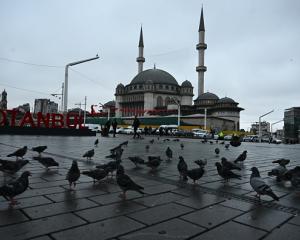The gargantuan eruption of the underwater Hunga Tonga-Hunga Ha’apai volcano created the planet’s largest explosion in 140 years, sending the equivalent of 58,000 swimming pools of water into the atmosphere.
It also triggered a rare pressure shockwave that travelled the globe multiple times and a cascade of lingering effects that may see Earth cross the global warming landmark of 1.5C sooner than expected.
Now, in a just-published study, New Zealand researchers have shed fresh light on the wall of water it sent into Tonga’s home islands soon after the January 15, 2021 blow.
Travelling more than 100km from the eruption site at a speed of at least 500 km/h, the tsunami knocked out communications and destroyed villages and resorts on Tonga’s main island of Tongatapu, while devastating parts of the ‘Eua and several islands in the southern Ha’apai island group.
Remarkably, just a handful of people were killed in the disaster, as most of the population had just enough warning, foresight and preparedness to evacuate to higher ground.
In the aftermath, officials estimated that waves which struck the west coasts of the Tongatapu, ʻEua and Haʻapai islands reached 15m – or the height of a four-storey building.

“We knew the tsunami was big in some places, but we did not know how big or how widespread,” said Dr Jose Borrero, a tsunami scientist with Raglan-based eCoast Solutions eCoast Marine Consulting and Research.
Answering that question wasn’t straight-forward, given experts were effectively trying to separate the effects of two tsunami: one caused by the volcano itself blowing up, and another from the pressure shockwave it generated.
While local science services were able to provide them some information, the rest initially had to be gleaned from news videos and eye-witness accounts.
To help fill in the gaps, Borrero teamed up with University of Auckland volcanologist Professor Shane Cronin, who was able to travel to Tonga soon after the eruption to carry out early field surveys.
A key focus was calculating the tsunami’s run-up – or its height above sea level at the farthest point it reached on the shore.
“In big events it is pretty easy, you find huge piles of debris at the inland extent,” Borrero said.
“You can also see where the surge had stripped branches, leaves and bark from trees or left mud lines on the sides of walls or buildings that are still standing.”
Cronin, who was initially focused on mapping and sampling volcanic ash before it was washed away by the rainfall, said: “It wasn’t until I started working on the tsunami run-up measurements and impact assessments did I realise just how devastating this aspect of the eruption was”.

“The wave fundamentally laid bare coral rock at the coast, stripping off soil, trees and buildings alike,” Cronin said.
“Cars were wrapped around the few strong trees remaining, crumpled like tinfoil with embedded coral rock, branches and debris.
“I quickly changed my focus to tsunami studies and spent the next month travelling with local scientists to every beach and island we could reach, with the help of the local police and Navy.”
The team used special surveying equipment to measure distances and elevations along specific transects, which could then be cross-referenced with satellite and drone imagery.
“Surveying by foot every day revealed the tragedy of the event, with sobering reminders of peoples’ lives represented in the rubble with torn clothing, toys and domestic appliances,” Cronin said.
“It will take a long time for people to rebuild their lives and for many to recover their peace of mind.
“Almost everyone I spoke to during the surveys, especially children, remain terrified by loud noises and the threat from the seas.”
To get a specific bearing on the timing of the surges, Borrero and Cronin’s team spoke with a large number of locals who were on the ground at the time.
The most crucial of these interviews were with Moana Paea of the Ha’atafu Beach resort, and with Rachael Moore, the Australian High Commissioner to Tonga – both of whom had been on the west coast of Tongatapu.
Those accounts helped the scientists establish the islands had actually been hit by two distinct surges.
“That there was a later wave was known to us from the very beginning, since the weather station, which was destroyed at Kanokupolu on the west coast of Tongatapu, transmitted a data packet at 6pm local time,” Borrero said.
That weather station happened to be attached to a cellphone tower that stood at 13m above sea level – and remnants of both were later found several hundred metres inland.
Contrary to early assumptions, Borrero said this piece of the puzzle proved that a tsunami which rushed in soon after the eruption’s thunderous boom was heard at 5.15pm wasn’t the “main event”.
“The big one arrived sometime after 6pm, based on the weather station data and the information from the eyewitnesses.”
Their new study, published in the journal Pure and Applied Geophysics, also confirmed the height of these waves were roughly five metres above initial estimates.
Cronin’s team measured that they’d reached around 19m on the west coast of Tongatapu, along with 20m at Nomuka Iki in the Ha’apai Islands and 20m at Tofua island.
“These three sites basically encircle the Hunga volcano, so it suggests a wave that extended radially from the volcano,” Borrero said.
“The tsunami height was greatly diminished along the northern coast of Tongatapu due to the extensive offshore reefs that dissipated the wave energy.”
Ultimately, the study reinforced the tsunami danger that large undersea eruptions – such as those from the Tonga and Kermadec ridges above New Zealand - could pose.
“Of course, the problem is that there have been so few such events we really don’t know enough about them,” Borrero said.
In recent years, New Zealand scientists have been modelling different ways that volcanoes could send huge waves surging toward land, ranging from super-heated pyroclastic flows hitting the ocean, to the collapse of an underwater caldera.
Cronin and colleagues are currently trying to piece together all parts of last year’s eruption sequence to understand the diverse range of events that occurred.
“Based on the timing of changes in eruption intensity and the eruption plume height, my current theory is that the big tsunami wave was caused by a combination of the central part of the volcano collapsing and a sudden change from a single high plume to a laterally spreading set of pyroclastic flows,” he said.
For the public, Borrero said the study’s big take-home message was to heed natural warnings.
“The near-complete lack of casualties was certainly partly to do with the fact that there was a time-gap between the first moderate tsunami that everybody saw and reacted to, and the big one that came after 6pm,” he said.
“One of the key natural warnings for tsunami is to beware of unusual water motion, surges and withdrawals.
“Of course, this event was lacking the ‘strong ground shaking’ part of the natural warning repertoire, but the fact that there was a giant volcano going off nearby was part of it as well.”












